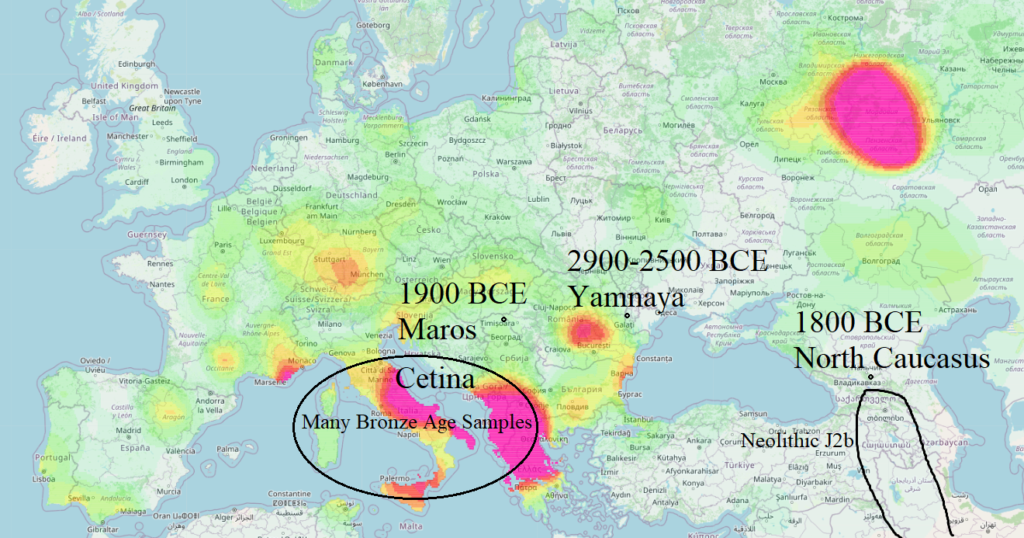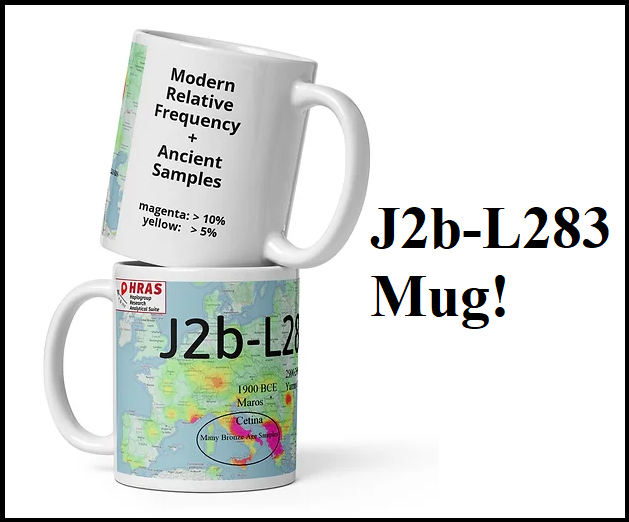Anthropological sex: male.
Supplementary material, “The Genetic Origin of the Indo-Europeans” Laziridis et al. 2024
Molecular sex: male, with an unusual Y-haplogroup J2b2a1 (J-L283).
Biological age at death: about 30 years (young adult).
Pathologies: supragingival calculus; active porotic hyperostosis (cribra cranii).
The skeleton is very robust, with extremely pronounced muscle insertions, with extensive enthesopathic changes on the humerus and femurs. The individual exhibits a very large skeletal stature, at least 181 cm.
Traumas: a perimortem fracture in the middle third of the right clavicle.
The burial must be attributed to Cernavodă-I or Yamnaya cultures.”
He was killed by a blow to the clavicle, had gingivitis and may have been starving to death or possibly the low iron content in his body was due to his having been fighting off an infection.
The sample is 83.7% Core Yamna and 16.3% YUN_CA (Yunatsite Chalcolithic) according to a paper released at the same time by the same team, “A genomic history of the North Pontic Region from the Neolithic to the Bronze Age“.
I haven’t read the second paper yet so this post is only about conclusions from the first.

In this paper, thanks to 299 new ancient samples having been sequenced, we now have the most highly resolved model to date of the genetic relationships between steppe populations and their neighbors from the Neolithic to the Bronze Age.
While the paper represents a breakthrough for J2b-L283 research, you will find no mention of this haplogroup in the paper, only in one of the tables attributing it as the haplogroup of I10206, a 2900-2500 BCE Yamnaya sample from Crihana-Veche, Moldova. And in the supplementary material I quoted above.
By the way, the Cernavodă culture, according to Wikipedia, occupied the territory of the Karanova and Gumelniţa cultures, for which a destruction horizon was evident. Burials and pottery resemble Serednii Stih.
In the rest of this post I’ll simply ascribe this sample as Yamnaya because that is how he is classified in the table.
This study is important for J2b-L283 origins research because:
- The ancient sample I10206, being J2b-L283 and, according to authors, Yamnaya, confirms the prior consensus theory of an association with migrating Indo-European groups that may have been the vector of J2b-L283 migration from the North Caucasus to Europe.
- Discovery of a “Caucasus – Lower Volga” (CLV) cline that represents genetic admixture along a continuum between a Caucasus Neolithic southern end in Neolithic Armenia and a steppe northern end in the Lower Volga. This demonstrates how our line may have migrated out of the Caucasus and mixed with steppe herders before moving west, toward Europe, as an admixed group.
Yamnaya are modeled from two groups, both had CHG
Yamnaya are best modeled as the mixture of two groups, 74% Serednii Stih (SShi subset, Ukraine) and 26% Remontoye (North Caucasus). Both constituent groups themselves had a Caucasus component, with that of Remontoye being about half Caucasus-derived. The Remontoye or a related group migrated west to mix with Serednii Stih to form Yamnaya.
The source population of the Caucasus component of Remontoye could be a yet unsampled population from the North Caucasus. The paper mentions, as a possibility that demonstrates archaeological contact from north to south, the North Caucasus Neolithic cemetery dated ~4800 BCE near Nalchik (not far from our KDC001 basal J2b-L283 who lived about 3000 years later).
Proto-Indo-Anatolian homeland as North Caucasus – Lower Volga
The study provides a linguistic theory based on a genetic admixture model that the homeland of the Proto-Indo-Anatolian language speakers was the North Caucasus – Lower Volga around 4400-4000 BCE.
In this model, sometime between 4400-4000 BCE, two groups split off from the homeland, one to the west that ultimately resulted in the Proto-Indo-European spoken by the Yamnaya and one to the south that resulted in the Anatolian language family, represented by Hittite and Luwian.
This means that if J2b-L283 had already diversified by then (slightly earlier than TMRCA is estimated):
- J2b-Z622 could represent a line that migrated west
- The ethnic Armenian basal sample from Kharberd/Harput, Elazığ Province of Turkey, could represent a survival of Anatolian-speaking groups such as the Hittites or Luwians that are now theorized to have migrated to Anatolia from the Proto-Indo-Anatolian homeland in the North Caucasus – Lower Volga. Or the slightly less exciting later migration of an ethnic Armenian to that area from Armenia, which is likely relatively near the origin J2b-L283.
- The ancient North Caucasus KDC001 from Kudachert (SE of Nalchik), Kabardino-Balkaria, can now more confidently be considered a remnant even if his exact geography may not reliably reflect the precise origin of J2b-L283 because he lived an estimated 1800 years after later the TMRCA and because the sample is low coverage and may not really be ‘completely’ basal.
While later migrations from elsewhere are possible, because neither Armenia nor the North Caucasus are places where we find many of the later, West-Central Balkans origin branches, I think we should appreciate that these rare locations are found among basal J2b-L283 and their relative proximity in the Caucasus, the Neolithic homeland of J2b.
Going more out on a limb with the Hungarian paraclade J-A28999
The first wave of steppe herders in Europe at the end of the 5th millennium BCE had Volga cline ancestry with apparently no Caucasus component (I don’t see it in the first figure). Some of them went as far as Csongrad, Hungary on the Tisza river.
While the samples so far sequenced apparently had no Caucasus component, an intrepid basal J2b-L283 could conceivably have migrated a bit up the Volga to mix with this group, parting with his cousins whose descendants went west with CLV cline populations a bit later (and with the possible Hittite and/or Armenian basal cousin whose ancestor went south).
So in this way, this Hungarian paraclade could possibly represent a migration of Volga cline populations to Hungary that had very little / no (recent, at least) Caucasus admixture.
Of course for this theory to have legs we would need to break the bottleneck from 5600 – 900 years ago and show that they were likely living in Hungary since the Chalcolithic. For now we only know that they may have been living in Hungary since at least 900 years.
Could this J2b-L283 have been a survivor from the preceding Gumelniţa cultures of Neolithic Moldova and Romania?
Probably not, but I think we cannot completely rule this out yet. After all, according to the other new paper about the North Pontic, he has 16.3% Yunasite ancestry. This was a Late Chalcolithic culture of Bulgaria, which “The sites of Hotnitsa and Yunasite in Bulgaria show numerous human skeletons in the final burnt layer, which suggests a massacre took place.” – Harvey Benjamin Smith, https://scholarworks.uark.edu/cgi/viewcontent.cgi?article=1588&context=etd
We also know that his female line, U4b3, is very strongly associated with Proto-Indo-Europeans because one line even migrated to South Siberia as a member of the Afanasievo culture. So if his mother was more or completely Yamnaya, it would mean that his father would have had even more Yunasite ancestry than his 16.3%. But his mother and father may have been equally admixed.
As Flor Veseli pointed out to me, it is important to note that there are two other R1b, likely R1b-Z2103, ancient samples from Moldova with nearly identical proportions of Yamnaya and Yunasite to I10206, namely I12512 and I17745 (seen in table of 2nd study). So, in this case, having this Yunasite autosomal component alone cannot be considered an indicator for carrying a Yunasite male line.
I cannot find much information on the Gumelniţa culture. It appears to be defined by a single typesite from the map on the Wikipedia article.
The Indo Europeans origin paper also mentions several individuals with Volga cline ancestry who replaced existing Neolithic populations in Mayaki and Giurgiulești with apparently no admixture with the preexisting inhabitants. They were living there at the end of the 5th millenium BCE and Wikipedia states the end of that culture at 3950 BCE, right afterward.
I find it improbable that J2b-L283 was living among Cucuteni-Trypillia farmers or other European farmers, as we see no growth of J2b-L283 during the heyday of their civilization when they had the largest settlements in the world. Instead we start diversifying right before the downfall of Cucuteni-Trypillia whose last stage is 3500-3000 BCE.
There is then another issue with assuming I10206 may have already been living in Moldova when the Yamnaya arrived. It requires an explanation for how this J2b-L283 migrated there from the Caucasus / Zagros that cannot rely on an archaeologically well-attested vector (i.e. westward migration of steppe herders).
Mentioned in the beginning part of the paper, there is such an explanation. The Yamnaya inherited a Caucasus component from the west from the European farming populations that their ancestors admixed with and which was absent from original steppe populations.
Flor Veseli brought to my attention the bombshell that in the North Pontic paper preprint is a 3354-3103 calBCE ancient sample from Bursuceni Moldova who is J2b-Z2453-Z42942 and who had substantial Aknashen Neolithic ancestry. They have a male line TMRCA with the ancient Shulaveri-Shomu samples, Mentesh Tepe 23 and 26, who lived about 8700 years ago. Thus, a population containing J2b-Z42942 males was apparently one of the vectors introducing Caucasus Neolithic to ancestry to the North Pontic. This development deserves its own dedicated post and I’ll need to read that paper first.
Enjoy a dreamy cup of tea with my new J2b-L283 mug while pondering the origins of your male line ancestors
If you appreciate my efforts for J2b-L283 research, consider purchasing this cool new J2b-L283 mug! This helps me keep the lights on.
I have also recently designed a stylish “It was Romans” mug.
https://hunterprovyn.wixsite.com/phylogeographer/category/all-products

